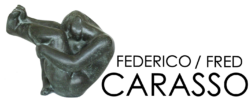OVER ONS
OVER ONS
Deze website is een initatief van de Stichting Federico Antonio Carasso en de nazaten van Fred Carasso. Speciale dank gaat uit naar de zonen van Fred: historicus Dedalo Carasso (1940-1995) en natuurkundige Marino Carasso (1943-2019), die elk vanuit hun eigen expertise het werk van hun vader tot een blijvende herinnering hebben gemaakt.
STICHTING FEDERICO ANTONIO CARASSO
KvK 41214889
BESTUUR
Deirdre Carasso (voorzitter)
Jan Teeuwisse (penningmeester)
Vera Carasso (secretaris)
INVENTARISATIE OEUVRE
Kunsthistorica Jeanette Wagenaar heeft in de periode 2008/2009 als gastconservator gewerkt aan de tentoonstelling in Beelden aan Zee: Atelier Carasso – Het laboratorium van een beeldhouwer. Daarvoor heeft zij een inventarisatie gemaakt van de ca. 900 beelden en penningen. Deze werkzaamheden heeft zij in opdracht van de stichting in de periode 2016/2017 voortgezet. De stichting en de familie Carasso zijn haar zeer dankbaar voor de inzet om dit grote oeuvre in beeld te krijgen.
PROMOTIEONDERZOEK 2020 – HEDEN
In januari 2020 is Matisse Huiskens begonnen met zijn promotieonderzoek aan de Universiteit van Amsterdam en die van Salerno. Op LinkedIn beschrijft hij het onderzoek zelf als volgt:
Project Title: The Formation of Artistic and Political Identities in Exile. Fred Carasso in Brussels and Amsterdam, 1928-1958
Supervisor: dr. A.A. Witte, co-supervisors: prof. dr. C-M.K.E. Lerm Hayes, dr. S. Zuliani.
The rich yet largely unknown inheritance of the Italian-born artist Fred Carasso (1899- 1969) makes up for the understudied relations between Italy and The Netherlands in the first half of the twentieth century. First active in the Communist circles of Turin, Carasso moved to Paris when the Fascist regime came to power in 1922. This study looks at Carasso’s artistic and political identities during his later exile in Brussels (1928- 1933) and Amsterdam (1934-1958). It analyses his artworks and writings to answer how these identities were formed and performed at the intersections between artistic production, criticism and politics.
Carasso, predominantly known as a sculptor, was part of many different networks and thus calls for an interdisciplinary approach. A performative perspective derived from fields such as sociology and gender studies will help to interpret Carasso’s different identities during his life in exile. In migration studies, the issue of identity is often raised: this study proposes to explore its complexities on an individual, micro-level. In terms of scope, then, the breadth of an all-encompassing view is sacrificed to the depth of the case study. Each of the case studies, translated into five chapters, takes a specific object or event (a book, building, journal, monument and exhibition) as their starting point and then follows his trajectories in Brussels, Amsterdam and abroad. As a result, this enables us to retrace Carasso’s networks and illuminates on how, through his writings and works, he performed identities in them.
As a joint doctorate project, the research is conducted in collaboration with the Amsterdam School of Heritage, Memory and Material Culture (AHM) at the University of Amsterdam and the Department of Cultural Heritage Studies (DiSPaC) at the University of Salerno.
